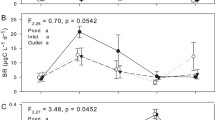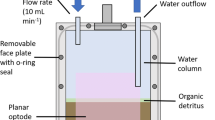ABSTRACT
Planktonic bacterial production in the tidal freshwater Hudson River is a major component of secondary productivity and is uncoupled from planktonic primary productivity. There are several major sources of allochthonous dissolved organic carbon (DOC) whose potential contribution to heterotrophic bacterial growth was examined with bioassays. Supply of DOC from the upper Hudson drainage basin and a large tributary in the mid-Hudson together comprise 70 kT DOC/year, which is the bulk of the DOC load to the tidal freshwater Hudson River. Two contrasting tidal wetlands contribute DOC to the main-stem river but were only a few percent of the tributary load even during summer low-flow conditions. The quantity of DOC released from fine sediments was intermediate to the other two loadings considered. Bacterial growth in bioassays receiving water from the sources varied, but differences in thymidine incorporation between reference and DOC sources were small, usually less than 2 nmol/L/h. Similarity in thymidine incorporation suggests that all sources of DOC were capable of supporting bacterial growth at approximately equal rates. Seasonal shifts in carbon availability were clear in several cases, for example, greater growth on wetland-derived DOC at times of peak plant productivity. Seasonal differences in tributary DOC bioavailability were not large despite the well-known seasonality of tributary inputs. Activities of a suite of extracellular enzymes were used as a biologically based characterization of DOC from the various sources. Shifts in allocation among enzymes were apparent, indicating that there are biologically relevant differences in composition among the sources. Fluorescence characteristics and absorbance per unit carbon also varied among sources, providing an independent confirmation of compositional differences among sources. The absence of large differences in bacterial productivity among sources suggests that growth is supported by a wide range of DOC, and the relative importance of the sources is probably related to the quantitative differences in inputs. Efforts to classify carbon supplies to ecosystems must recognize that organism plasticity in carbon use and physical mixing processes will both act to homogenize what might initially appear to be quite distinctive carbon inputs.
Similar content being viewed by others
Author information
Authors and Affiliations
Additional information
Received 15 April 1997; accepted 17 February 1998
Rights and permissions
About this article
Cite this article
Findlay, S., Sinsabaugh, R., Fischer, D. et al. Original Articles: Sources of Dissolved Organic Carbon Supporting Planktonic Bacterial Production in the Tidal Freshwater Hudson River. Ecosystems 1, 227–239 (1998). https://doi.org/10.1007/s100219900018
Issue Date:
DOI: https://doi.org/10.1007/s100219900018




